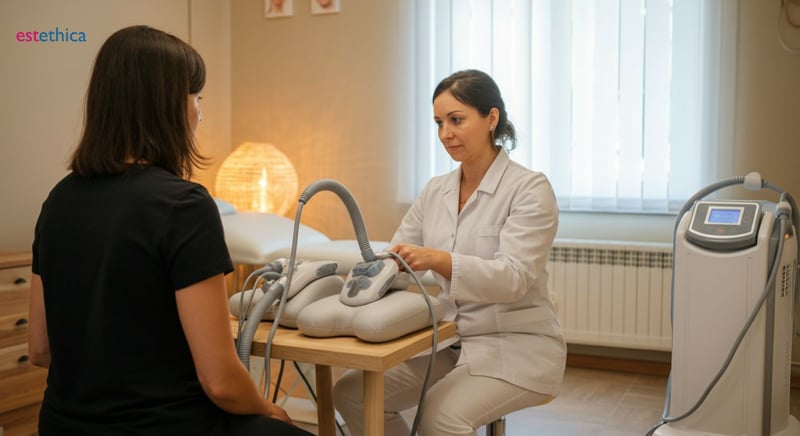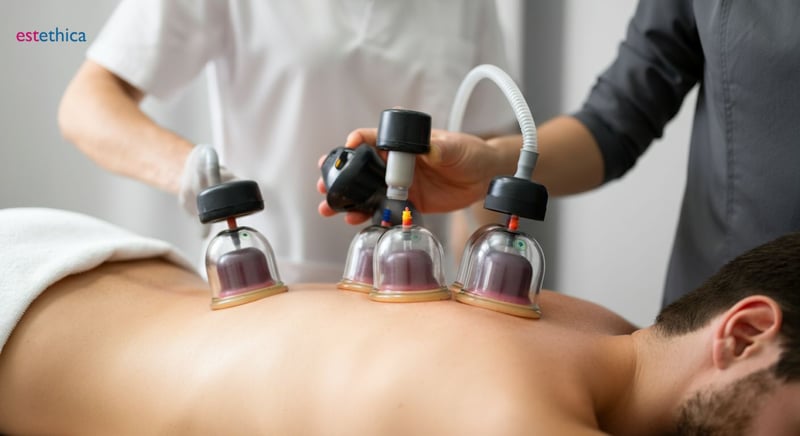Unlocking Wellness: The Transformative Benefits of Hacamat Therapy
Unlock the secrets of Hacamat Therapy—a traditional practice offering modern wellness solutions.
Cupping therapy, known as Hacamat, is a form of traditional medicine that dates back thousands of years. This therapeutic method is gaining renewed attention in modern healthcare for its potential to cleanse the body, enhance overall well-being, and alleviate chronic ailments. As we delve into this ancient practice, discover why it stands the test of time and how it might benefit you today.
What is Hacamat? Understanding Its Healing Principles
The Historical Roots of Hacamat
Hacamat, also known as wet cupping, is a traditional healing practice with origins in ancient Egypt and China. This technique involves placing small, heated cups on the skin to create suction, which is believed to draw out toxins and enhance blood circulation. The historical use of Hacamat highlights its significance in alternative medicine, where it was employed to treat various ailments and promote overall well-being.
Benefits of Cupping Therapy
- Improves blood circulation, aiding in faster recovery from muscle fatigue.
- Helps in detoxification by drawing out impurities from the body.
- Reduces inflammation, providing relief from chronic pain conditions.
These benefits make Hacamat a popular choice for those seeking holistic health solutions. For instance, athletes often use cupping therapy to enhance performance and speed up recovery times.
Understanding the Hacamat Process
- Preparation: The practitioner cleans the skin and selects appropriate points for cupping.
- Application: Heated cups are placed on the skin, creating a vacuum effect.
- Completion: After a few minutes, the cups are removed, and the skin is cleaned again.
This process is designed to be safe and effective, with practitioners ensuring that the technique is tailored to individual needs. The methodical approach of Hacamat underscores its role in traditional healing methods, offering a unique blend of ancient wisdom and modern health practices.

Exploring the Top Benefits of Cupping Therapy for Health
Cupping Therapy and Its Impact on Chronic Conditions
Cupping therapy, also known as Hacamat treatment, offers significant relief for chronic conditions such as migraines and arthritis. By enhancing lymphatic flow, it aids in reducing inflammation, which is a common cause of chronic pain. For instance, individuals suffering from arthritis often experience a decrease in joint stiffness and pain after regular sessions. Similarly, migraine sufferers report fewer and less intense headaches, attributing this improvement to the detoxifying effects of cupping.
Key Health Benefits of Cupping Therapy
- Facilitates the removal of heavy metals from the body, promoting overall detoxification.
- Alleviates musculoskeletal pains, providing a natural alternative to pain relief medications.
- Improves lymphatic circulation, enhancing the body's natural healing processes.
These benefits make cupping therapy a valuable tool in holistic health practices. For example, athletes frequently use it to maintain peak physical condition, while individuals with sedentary lifestyles find it helpful in managing back pain.
- Initial Consultation: Discuss health concerns and goals with a qualified practitioner.
- Therapy Session: Cups are strategically placed to target specific health issues.
- Post-Treatment Care: Follow-up advice is provided to maximize the therapy's benefits.
This structured approach ensures that cupping therapy is both safe and effective, tailored to meet individual health needs. By focusing on personalized care, practitioners can help clients achieve optimal health outcomes through this traditional healing method.

How Hacamat Can Alleviate Back Pain and Migraines
Targeting Pressure Points for Pain Relief
Hacamat therapy, a form of cupping, is renowned for its ability to alleviate back pain and reduce migraine frequency. By focusing on specific pressure points, it enhances blood flow and reduces muscle tension, providing significant relief. For example, individuals with chronic back pain often experience improved mobility and reduced discomfort after regular sessions. Similarly, migraine sufferers report fewer headaches, attributing this to the therapy's ability to release tension in the neck and shoulders.
The Detoxifying Process and Its Benefits
- Reduces inflammation, promoting natural healing and pain relief.
- Enhances circulation, which aids in the removal of toxins from the body.
- Boosts the immune system, helping the body to recover more efficiently.
These benefits make Hacamat a valuable tool for those seeking alternative medicine solutions. For instance, individuals with inflammatory conditions find relief through the therapy's detoxifying effects, which help reduce swelling and pain.
- Assessment: Identify specific areas of pain and tension.
- Application: Use cups to create suction on targeted pressure points.
- Follow-up: Evaluate the therapy's effectiveness and adjust as needed.
This methodical approach ensures that Hacamat therapy is tailored to individual needs, maximizing its effectiveness in alleviating back pain and migraines. By integrating traditional healing methods with modern understanding, practitioners offer a holistic health solution that addresses both symptoms and underlying causes.

Hacamat and Modern Health: Integrating Tradition with Innovation
Blending Hacamat with Contemporary Therapies
Hacamat therapy, a cornerstone of traditional healing, is increasingly being integrated with modern medical practices to enhance its therapeutic effects. This integration is particularly evident in its combination with acupuncture, where both therapies complement each other to optimize relaxation and stress relief. For instance, a patient undergoing Hacamat for back pain might also receive acupuncture to target specific meridian points, enhancing the overall efficacy of the treatment.
Innovative Approaches to Hacamat Therapy
- Combining Hacamat with physiotherapy to improve mobility and reduce recovery time.
- Using advanced diagnostic tools to tailor Hacamat sessions to individual health profiles.
- Integrating Hacamat with mindfulness practices to enhance mental well-being.
These innovative approaches demonstrate the versatility of Hacamat in modern healthcare settings. For example, athletes may benefit from a combination of Hacamat and physiotherapy to expedite recovery from injuries, while individuals dealing with stress might find relief through sessions that incorporate mindfulness techniques.
- Assessment: Evaluate the patient's health needs and determine suitable complementary therapies.
- Integration: Combine Hacamat with selected modern treatments for a holistic approach.
- Evaluation: Monitor the patient's progress and adjust the treatment plan as necessary.
This structured integration ensures that Hacamat therapy is not only effective but also adaptable to the evolving landscape of modern medicine. By bridging traditional and contemporary practices, healthcare providers can offer comprehensive solutions that address both physical and mental health challenges.
Is Hacamat Safe? Understanding Risks and Precautions
Ensuring Safe Hacamat Practices
Hacamat therapy, while beneficial, requires careful consideration of safety protocols to minimize risks. Ensuring that the practice is conducted by trained professionals in a clean environment is paramount. For instance, practitioners must use sterilized equipment to prevent infections. Additionally, understanding the patient's medical history is crucial to avoid adverse reactions. This approach not only safeguards the patient's health but also enhances the effectiveness of the therapy.
Potential Risks and How to Mitigate Them
- Infection: Use of sterile equipment and proper hygiene practices.
- Skin Irritation: Conducting a patch test to check for sensitivities.
- Bruising: Educating patients about possible temporary marks.
These precautions are essential in ensuring a safe and beneficial Hacamat experience. For example, practitioners can mitigate skin irritation by applying soothing ointments post-treatment. By addressing these potential risks, Hacamat therapy can be a safe alternative medicine option for many individuals.
- Consultation: Discuss any health concerns and previous medical conditions.
- Preparation: Ensure all equipment is sterilized and the environment is clean.
- Monitoring: Observe the patient during and after the session for any adverse effects.
This structured approach to Hacamat therapy emphasizes the importance of safety and personalized care. By adhering to these guidelines, practitioners can provide a secure and effective treatment, allowing patients to enjoy the benefits of this traditional healing method without unnecessary risks.
Finding the Best Hacamat Practitioners Near You
Qualities of a Certified Hacamat Practitioner
When seeking Hacamat therapy, it's crucial to find a certified practitioner to ensure safety and effectiveness. Certified practitioners possess extensive knowledge of traditional healing methods and modern health practices. For example, they understand the intricacies of pressure points and how to tailor treatments to individual needs. Additionally, they maintain high hygiene standards, using sterilized equipment to prevent infections. This expertise not only enhances the therapy's benefits but also ensures a safe experience for clients.
Steps to Identify the Best Hacamat Practitioners
- Research: Look for practitioners with certifications from recognized institutions.
- Consultation: Schedule an initial meeting to discuss your health goals and concerns.
- Feedback: Seek reviews and testimonials from previous clients to gauge satisfaction.
These steps help in identifying practitioners who are not only skilled but also align with your health objectives. For instance, a practitioner with positive feedback on their ability to alleviate back pain might be ideal for someone seeking relief from chronic discomfort.
Key Considerations When Choosing a Practitioner
- Experience: Ensure the practitioner has substantial experience in Hacamat therapy.
- Specialization: Some practitioners specialize in specific areas, such as pain relief or detoxification.
- Approach: Consider their approach to integrating traditional and modern techniques.
These considerations are vital in selecting a practitioner who can provide personalized care. For example, if you're interested in Hacamat for back pain relief, a practitioner specializing in musculoskeletal issues would be beneficial. By focusing on these factors, you can find a practitioner who meets your specific needs and enhances your overall health journey.
Innovative Integration of Hacamat with Modern Therapies
Ensuring Safe and Effective Hacamat Practices
Frequently Asked Questions
What are the main benefits of Hacamat therapy?
How does Hacamat therapy help with migraines and back pain?
What should I consider when choosing a Hacamat practitioner?
Are there any risks associated with Hacamat therapy?
How is Hacamat therapy integrated with modern healthcare practices?
Discover the Path to Healthy Beauty with estethica's Award-Winning Services!
📞 Call Now for Your Free Consultation!